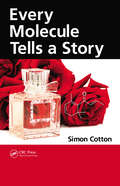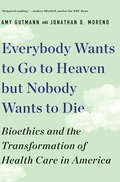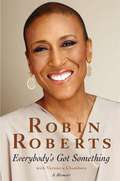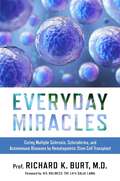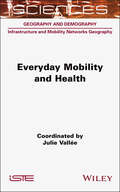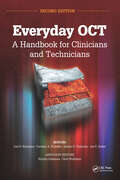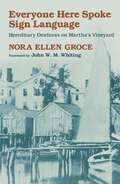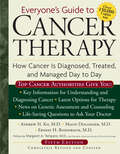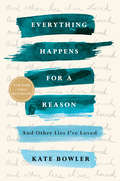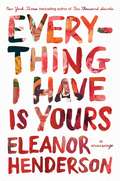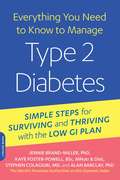- Table View
- List View
Every Minute Is a Day: A Doctor, an Emergency Room, and a City Under Siege
by Dan Koeppel Robert MeyerAn urgent, on-the-scene account of chaos and compassion on the front lines of ground zero for Covid-19, from a senior doctor at New York City&’s busiest emergency room &“Remarkable and inspiring . . . We&’re lucky to have this vivid firsthand account.&”—A. J. Jacobs, bestselling author of The Year of Living Biblically When former New York Times journalist Dan Koeppel texted his cousin Robert Meyer, a twenty-year veteran of the emergency room at Montefiore Medical Center in the Bronx, at the beginning of the Covid-19 crisis in the United States, he expected to hear that things were hectic. On a scale of 1 to 10, 10 being overwhelmed, where do you think you are? Koeppel asked. Meyer&’s grave reply—100—was merely the cusp of the crisis that would soon touch every part of the globe. In need of an outlet to process the trauma of his working life over the coming months, Meyer continued to update Koeppel with what he&’d seen and whom he&’d treated. The result is an intimate record of historic turmoil and grief from the perspective of a remarkably resilient ER doctor. Every Minute Is a Day takes us into a hospital ravaged by Covid-19 and is filled with the stories of promises made that may be impossible to keep, of life or death choices for patients and their families, and of selflessness on the part of medical professionals who put themselves at incalculable risk. As fast-paced and high-tempo as the ER in which it takes place, Every Minute Is a Day is at its core an incomparable firsthand account of unrelenting compassion, and a reminder that every human life deserves a chance to be saved.
Every Molecule Tells a Story
by Simon CottonWritten by a seasoned teacher, speaker, and writer in the field of chemistry, this text serves to provide a guide to the chemicals that make life possible and enrich the senses, as well as those that endanger it. This text combines the science and history of certain molecules and deals with the chemistry of each substance in an interesting and easily understandable manner. Topics covered include substances found in air and water, food, hydrocarbons, acids and alkalis, natural killers, unnatural killers, destructive molecules, pleasure molecules, natural healers, man-made healers, giant molecules, and vitamins.
Every Note Played
by Lisa Genova&“Unsparing in her depiction of the disease&’s harrowing effects, neuroscientist Genova also celebrates humanity.&” —People &“Sometimes it&’s easier to tell truth in fiction…And she tells it with heart and hope.&” —NPR &“Her juxtaposition of scientific detail with compassionate, heartfelt storytelling is unparalleled.&” —Bookreporter &“Every Note Played will grip and gut you.&” —The Boston Globe From neuroscientist and New York Times bestselling author of Still Alice comes a powerful exploration of regret, forgiveness, freedom, and what it means to be alive.An accomplished concert pianist, Richard received standing ovations from audiences all over the world in awe of his rare combination of emotional resonance and flawless technique. Every finger of his hands was a finely calibrated instrument, dancing across the keys and striking each note with exacting precision. That was eight months ago. Richard now has ALS, and his entire right arm is paralyzed. His fingers are impotent, still, devoid of possibility. The loss of his hand feels like a death, a loss of true love, a divorce—his divorce. He knows his left arm will go next. Three years ago, Karina removed their framed wedding picture from the living room wall and hung a mirror there instead. But she still hasn&’t moved on. Karina is paralyzed by excuses and fear, stuck in an unfulfilling life as a piano teacher, afraid to pursue the path she abandoned as a young woman, blaming Richard and their failed marriage for all of it. When Richard becomes increasingly paralyzed and is no longer able to live on his own, Karina becomes his reluctant caretaker. As Richard&’s muscles, voice, and breath fade, both he and Karina try to reconcile their past before it&’s too late. Poignant and powerful, Every Note Played is a masterful exploration of redemption and what it means to find peace inside of forgiveness.
Every Patient Tells A Story: Medical Mysteries And The Art Of Diagnosis
by Lisa SandersMaking a diagnosis is a doctor's most challenging and crucial task. Most of the time, a physical examination and routine tests provide what's needed to begin a course of treatment. But sometimes the symptoms are deceptive, tests are misleading, and obvious treatment options prove woefully inadequate. In Diagnosis Dr. Lisa Sanders tells the true stories of doctors facing complex medical mysteries to illustrate the art and science of diagnosis. A healthy young man complains of memory loss so severe that he can't remember the events of the last hour. A young woman lies dying in ICU and no one knows what is killing her. What does a doctor do when the patient profile says one thing and the tests say another? As Sanders describes the process of solving these and other diagnostic dilemmas, she provides a firsthand view of the combination of expertise and intuition that results in accurate diagnosis, while portraying how knowing medicine is essential but not sufficient to unravel the complexities of illness.
Everybody Wants to Go to Heaven but Nobody Wants to Die: Bioethics And The Transformation Of Health Care In America
by Amy Gutmann Jonathan D. MorenoAn incisive examination of bioethics and American healthcare, and their profound affects on American culture over the last sixty years, from two eminent scholars. An eye-opening look at the inevitable moral choices that come along with tremendous medical progress, Everybody Wants to Go to Heaven but Nobody Wants to Die is a primer for all Americans to talk more honestly about health care. Beginning in the 1950s when doctors still paid house calls but regularly withheld the truth from their patients, Amy Gutmann and Jonathan D. Moreno explore an unprecedented revolution in health care and explain the problem with America’s wanting everything that medical science has to offer without debating its merits and its limits. The result: Americans today pay far more for health care while having among the lowest life expectancies and highest infant mortality of any affluent nation. Gutmann and Moreno—“incisive, influential, and pragmatic thinkers” (Arthur Caplan)—demonstrate that the stakes have never been higher for prolonging and improving life. From health care reform and death-with-dignity to child vaccinations and gene editing, they explain how bioethics came to dominate the national spotlight, leading and responding to a revolution in doctor-patient relations, a burgeoning world of organ transplants, and new reproductive technologies that benefit millions but create a host of legal and ethical challenges. With striking examples, the authors show how breakthroughs in cancer research, infectious disease, and drug development provide Americans with exciting new alternatives, yet often painful choices. They address head-on the most fundamental challenges in American health care: Why do we pay so much for health care while still lacking universal coverage? How can medical studies adequately protect individuals who volunteer for them? What’s fair when it comes to allocating organs for transplants in truly life-and-death situations? A lucid and provocative blend of history and public policy, this urgent work exposes the American paradox of wanting to have it all without paying the price.
Everybody's Got Something
by Veronica Chambers Robin Roberts"Regardless of how much money you have, your race, where you live, what religion you follow, you are going through something. Or you already have or you will. As momma always said, "Everybody's got something." <P> So begins beloved Good Morning America anchor Robin Roberts's new memoir in which she recounts the incredible journey that's been her life so far, and the lessons she's learned along the way. With grace, heart, and humor, she writes about overcoming breast cancer only to learn five years later that she will need a bone marrow transplant to combat a rare blood disorder, the grief and heartbreak she suffered when her mother passed away, her triumphant return to GMA after her medical leave, and the tremendous support and love of her family and friends that saw her through her difficult times. <P> Following her mother's advice to "make your mess your message," Robin taught a nation of viewers that while it is true that we've all got something -- a medical crisis to face, aging parents to care for, heartbreak in all its many forms --- we've also all got something to give: hope, encouragement, a life-saving transplant or a spirit-saving embrace. As Robin has learned, and what readers of her remarkable story will come to believe as well, it's all about faith, family and friends. And finding out that you are stronger, much stronger, than you think.<P>
Everyday Activities to Help Your Young Child with Autism Live Life to the Full
by Debra S. Jacobs Dion E. BettsDoes your child struggle with brushing their teeth? Is it difficult to get them dressed and undressed each day? Do they struggle to understand their body's relationship to the world?This book is brimming with simple ideas, activities and exercises to address these daily challenges that young children with autism face. Easy to carry out and to fit into your routines, they will help improve a child's sense of body awareness, coordination and motor skills, and address key tasks such as eating meals and healthy sleep. There are also ideas for tackling social challenges, including playing with friends, going on holiday and staying calm at school. The final chapter of the book explains the different support professionals parents of a child with autism are likely to encounter and how each can help their child. This jargon-free book shows how occupational therapy techniques can be used to help your young child with autism to live life to the full, and will be an essential tool for parents and carers.
Everyday Activities to Promote Visual Efficiency: A Handbook for Working with Young Children with Visual Impairments
by Rona Shaw Ellen TriefEarly intervention services are essential for infants and toddlers who are visually impaired and have some functional vision that they will be able to use for everyday activities--not only to ensure their early development but also to help them learn to use their vision with maximum effectiveness, right from the start. Everyday Activities to Promote Visual Efficiency offers guiding principles for early intervention with very young children who are visually impaired and who may also have additional disabilities. This important new resource provides simple activities that can be incorporated easily by families and service providers into the everyday routines of a baby or child to facilitate early visual development and use of functional vision.
Everyday Chemicals: Understanding the Risks
by Gerald A. LeBlancWhat is the likelihood that common chemicals such as bisphenol-A, which is found in plastic water bottles, are harming us? Should shoppers be concerned about pesticide residues on fruits and vegetables in the supermarket produce aisle? Are we risking adverse health effects when we use insect repellent that contains DEET or slather on sunscreen? Modern life requires us to navigate an endless sea of chemicals. How do we know whether we need to worry about them?This book is a layperson’s guide to understanding chemical risk. The toxicologist Gerald A. LeBlanc offers a nontechnical overview of the key factors in evaluating whether exposure to chemicals in our daily lives could be harmful. He leads readers through the basic concepts of risk assessment using real-world examples. LeBlanc emphasizes that chemical hazard depends on the level of exposure and provides practical strategies for sensible decision making. The book features a series of accessible case studies describing how we all can reach rational conclusions about the danger of typical chemical exposures we experience every day.Giving nonexpert readers the tools to understand chemical risks, this book shows how critical thinking and science literacy can help us live with less fear and anxiety and make reasonable choices when confronted with potential hazards.
Everyday Chinese Medicine: Healing Remedies for Immunity, Vitality, and Optimal Health
by Mindi K. CountsAchieve vibrant health in every season with the holistic techniques of traditional Chinese medicine.This friendly guide to a 2,000-year-old lineage of healing wisdom integrates both the Five Element theory and the practices of traditional Chinese medicine to uncover what your body needs for balance and optimal health. Everyday Chinese Medicine demystifies, simplifies, and reveals patterns to help you take control of your own well-being from the comfort of your own home and kitchen. Mindi Counts—a holistic medical practitioner, acupuncturist, and herbalist—walks you through the seasons, elements, and organ systems to help you understand your unique constitution and how to achieve energetic and physical balance. With simple recipes, self-care practices, and time-tested herbal remedies, Everyday Chinese Medicine is the perfect companion on your path to complete wellness.
Everyday Community Practice: Principles and practice
by Amanda Howard Margot RawsthorneThis book provides a practical but sophisticated exploration of community development practice and is an accessible, relevant and contextualised guide for those studying social work and human services in Australia. This fully revised and expanded second edition (including new insights from communities preparing for, responding to, and recovering from disasters) draws on the experiences of not only the authors but many current practitioners from diverse backgrounds working alongside communities to support socially just change. The perspectives of these practitioners are drawn on throughout the book as well as in the exemplary projects case studies at the end of the book. Blending practical skills and ideas with a solid theoretical foundation, each chapter includes reflective questions and examples which can be used both in the classroom and in the field.Enabling students to feel better supported in challenging dominant individualised practice frameworks, it argues strongly that only collective action (supported by community development practice) can address significant social challenges such as those created by climate change, poverty and social exclusion.
Everyday Diabetes in Primary Care: A Case-Based Approach
by Jay ShubrookMore than 85% of people with diabetes receive their diabetes care in the primary care setting. With the busy primary care practitioner in mind, Everyday Diabetes in Primary Care: A Case-Based Approach offers dozens of diabetes cases in an easy-to-digest format—each representing a common clinical question that clinicians face in this common and complex area. For every case, fellowship-trained diabetologist Dr. Jay Shubrook shares his considerable expertise, providing authoritative, real-world guidance for your day-to-day management of patients with diabetes.
Everyday Evaluation on the Run: The user-friendly introductory guide to effective evaluation
by Yoland Wadsworth'Practical, useful counsel emanates throughout. Impressively grounded in real world experiences.' - Michael Quinn Patton, author of Utilisation-Focused EvaluationEffective evaluation can provide valuable insights into the way a program, a course or an organisation is being run, and direction for improvement. This widely-used introduction to evaluation is intended for non-specialists in the human services who need to do evaluation as part of a busy workload.Everyday Evaluation on the Run offers a practical over view of the main approaches to evaluation, strategies for involving stakeholders, and the evaluation industry's toolbox of models and techniques. The author emphasises the core principles and concepts of evaluation, and the idea of building a culture of evaluation.This third edition of Everyday Evaluation on the Run reflects current thinking on values in organisations and the need to use evaluation to guide future practice rather than just as an auditing process. With extensive examples, it is a handy reference for professionals and students in health, welfare, and community work, and in government and non-profit agencies.
Everyday Medical Ethics and Law
by BMA Medical Ethics DepartmentEveryday Medical Ethics and Law is based on the core chapters of Medical Ethics Today, focussing on the practical issues and dilemmas common to all doctors. It includes chapters on the law and professional guidance relating to consent, treating people who lack capacity, treating children and young people, confidentiality and health records. The title is UK-wide, covering the law and guidance in each of the four nations. Each chapter has a uniform structure which makes it ideal for use in learning and teaching. "10 Things You Need to Know About..." introduces the key points of the topic, Setting the Scene explains where the issues occur in real life and why doctors need to understand them, and then key definitions are followed by explanations of different scenarios. The book uses real cases to illustrate points and summary boxes to highlight key issues throughout. Whilst maintaining its rigorous attention to detail, Everyday Medical Ethics and Law is an easy read reference book for busy, practising doctors.
Everyday Miracles: Curing Multiple Sclerosis, Scleroderma, and Autoimmune Diseases by Hematopoietic Stem Cell Transplant
by Dr. Richard BurtA life-changing treatment is conquering auto-immune disorders—why doesn&’t anyone know about it? Thirty-five years ago, Dr. Richard Burt began a journey to treat chronic autoimmune diseases as they&’d never been treated before. Using a treatment originally developed for leukemia but modified to be more gentle—a one-time combination of immune targeting drugs followed by a transplant of the patient&’s blood stem cells—he has documented the successful and often dramatic reversal of multiple sclerosis, systemic sclerosis (scleroderma), chronic inflammatory demyelinating polyradiculoneuropathy (CIPD), neuromyelitis optica, and Crohn&’s disease. After decades of study and randomized trials, his approach, which has been duplicated in other parts of the world, is finally being recognized as an effective means of reversing these &“incurable&” diseases. Some of his patients have been symptom-free for more than twenty years, and in this book Dr. Burt tells their stories alongside his own journey of developing and refining the treatment, known as hematopoietic stem cell transplant (HSCT) for autoimmune disorders. &“These patients are the heroes,&” Dr. Burt has said. &“Their bodies and spirits faced unrelenting disease, and yet they fight valiantly against the suffering and obstacles.&” What is HSCT? How does it work? What are the risks? Why aren&’t more doctors talking about it? And why is it still out of reach for so many patients who could benefit from it? Dr. Burt answers these questions and many more. Written for the layperson, Everyday Miracles grants patients with autoimmune diseases and the people who love them insights into the revolutionary approach that could convert their life sentence into a one-time reversible illness.
Everyday Mobility and Health (ISTE Consignment)
by Julie ValléeEveryday mobility is neither favorable nor unfavorable to health. While it can facilitate social interactions, increase access to remote services, or encourage physical activity, it can also generate pollution, promote the spread of epidemics or cause traffic accidents. This book presents different facets of the relationship between daily mobility and health, focusing on the environments (geographical, social and political) that people live and move around in. It analyzes the role of mobility in the mechanisms of environmental exposure and diffusion, as well as the resulting health inequalities. It deals with active modes of travel (mainly walking and cycling) and the local contexts that are conducive to them. Finally, it offers a critical reading of the place given to everyday mobility in policies to combat obesity and rationalize regional healthcare provision.
Everyday OCT: A Handbook for Clinicians and Technicians
by James G. Fujimoto Joel S. Schuman Jay Duker Carmen A. PuliafitoOptical coherence tomography has become a part of clinical routine in everyday eye practice, allowing objective, quantitative structural assessment and driving clinical decision making in retinal diseases, glaucoma and cataract surgery. To guide the eyecare professionals who rely on this technology, Everyday OCT: A Handbook for Clinicians and Technicians, Second Edition is a user-friendly, practical reference that provides all of the information they need to know about current OCT technologies and their clinical utilities. Drs. Joel S. Schuman, Carmen A. Puliafito, James G. Fujimoto, and Jay S. Duker represent the cutting edge of OCT applications and, together with their expert contributing authors, they have created a clear and concise guide designed to provide clinicians and technicians with the knowledge and tips to best utilize OCT technology. This Second Edition is split into three parts: an operational guide with in-depth guidance and tips on the six major OCT devices from six different manufacturers, an interpretation guide featuring all the major pathologies OCT can visualize, and a technical guide containing detailed technical aspects of the SD-OCT and the future of OCT technologies.Everyday OCT, Second Edition explains how to: Set up and employ OCT technology Select and facilitate scans Ensure and assess the quality of scans Accurately interpret OCT images Everyday OCT: A Handbook for Clinicians and Technicians, Second Edition covers the diversity of new devices and applications in the field of OCT in a succinct and easy-to-read format, making it the ideal resource for clinicians and technicians to have by their side when performing or interpreting OCTs.
Everyday Technologies in Healthcare (Rehabilitation Science in Practice Series)
by Marcia Scherer Christopher M. Hayre Dave MullerThis book examines the role of everyday technology throughout the life cycle in order to demonstrate the wide acceptance and impact of everyday technology and how it is facilitating both practitioners and patients in contemporary practices. In response, then, this text speaks to a number of audiences. Students writing for undergraduate and postgraduate dissertations/proposals will find the array of works insightful, supported with a vast number of references signposting to key texts. For academics, practitioners and prospective researchers this text offers key empirical and methodological insight that can help focus and uncover originality in their own field. We anticipate that readers will find the collection of empirical examples useful for informing their own work, but also, it attempts to ignite new discussions and arguments regarding the application and use of everyday technology for enhancing health internationally. Explores the multifaceted use and application of each ‘everyday technology’ that impact on diagnosis, treatment and management of individuals. Examines an array of everyday technologies and how these that can either enhance and/or hinder patient/service user outcomes i.e. handheld devices, computer workstations, gamification and artificial intelligence. Discusses technologies that are intended to facilitate patient diagnosis, practitioner-patient relations, within an array of health contexts. Provides readers with an overview with future direction of everyday technologies and its limitations.
Everyone Here Spoke Sign Language: Hereditary Deafness on Martha's Vineyard
by Nora E. Groce<P>From the seventeenth century to the early years of the twentieth, the population of Martha's Vineyard manifested an extremely high rate of profound hereditary deafness. <P>In stark contrast to the experience of most deaf people in our own society, the Vineyarders who were born deaf were so thoroughly integrated into the daily life of the community that they were not seen-- and did not see themselves-- as handicapped or as a group apart. Deaf people were included in all aspects of life, such as town politics, jobs, church affairs, and social life. <P>How was this possible? On the Vineyard, hearing and deaf islanders alike grew up speaking sign language. This unique sociolinguistic adaptation meant that the usual barriers to communication between the hearing and the deaf, which so isolate many deaf people today, did not exist.
Everyone's Guide to Cancer Therapy: How Cancer Is Diagnosed, Treated, and Managed Day to Day
by Andrew Ko Malin Dollinger Ernest H. Rosenbaum&“Written by two oncologists . . . this authoritative but readable reference stands out . . . as a uniquely comprehensive, thorough source of up-to-date information&” (Library Journal). For more than thirty years, Everyone&’s Guide to Cancer Therapy has been the definitive resource for anyone confronting a cancer diagnosis. The revised and updated fifth edition draws on the latest research, information, and advice from more than 100 top oncology specialists. Equally informative and accessible, this comprehensive book helps cancer patients and their caregivers navigate through diagnosis, treatment, and supportive care. Topics include: * Information on recently approved targeted therapies for various cancer types * The newest strategies in cancer diagnosis and prevention * Cancer biology: translating scientific discoveries into meaningful advances for patients * Supportive care and complementary approaches
Everything Happens for a Reason: And Other Lies I've Loved
by Kate Bowler<P>Kate Bowler is a professor at Duke Divinity School with a modest Christian upbringing, but she specializes in the study of the prosperity gospel, a creed that sees fortune as a blessing from God and misfortune as a mark of God’s disapproval. <P>At thirty-five, everything in her life seems to point toward “blessing.” She is thriving in her job, married to her high school sweetheart, and loves life with her newborn son. Then she is diagnosed with stage IV colon cancer. <P>The prospect of her own mortality forces Kate to realize that she has been tacitly subscribing to the prosperity gospel, living with the conviction that she can control the shape of her life with “a surge of determination.” Even as this type of Christianity celebrates the American can-do spirit, it implies that if you “can’t do” and succumb to illness or misfortune, you are a failure. <P>Kate is very sick, and no amount of positive thinking will shrink her tumors. What does it mean to die, she wonders, in a society that insists everything happens for a reason? Kate is stripped of this certainty only to discover that without it, life is hard but beautiful in a way it never has been before. Frank and funny, dark and wise, Kate Bowler pulls the reader deeply into her life in an account she populates affectionately with a colorful, often hilarious retinue of friends, mega-church preachers, relatives, and doctors. <P>Everything Happens for a Reason tells her story, offering up her irreverent, hard-won observations on dying and the ways it has taught her to live. <P><b>A New York Times Bestseller</b>
Everything I Have Is Yours: A Marriage
by Eleanor HendersonA NEW YORK TIMES NOTABLE BOOK OF THE YEAR • From New York Times bestselling author Eleanor Henderson comes a turbulent love story meets harrowing medical mystery: the true story of the author’s twenty-year marriage defined by her husband’s chronic illness—and a testament to the endurance of love Eleanor met Aaron when she was just a teenager and he was working at a local record stored—older, experienced, and irresistibly charming. Escaping the clichés of fleeting young love, their summer romance bloomed into a relationship that survived college and culminated in a marriage and two children. From the outside looking in, their life had all the trappings of what most would consider a success story.But, as in any marriage, things weren’t always as they seemed. On top of the typical stresses of parenting, money, and work, there were the untended wounds of depression, addiction, and childhood trauma. And then one day, out of nowhere: a rash appeared on Aaron’s arms. Soon, it had morphed into painful lesions covering his body. Eleanor was as baffled as the doctors. There was no obvious diagnosis, let alone a cure. And as years passed and the lesions gave way to Aaron’s increasingly disturbed concerns about the source of his sickness, the husband she loved seemed to unravel before her eyes. A new fissure ruptured in their marriage, and new questions piled onto old ones: Where does physical illness end and mental illness begin? Where does one person end and another begin? And how do we exist alongside someone else’s suffering?Emotional, intimate, and at times agonizing, Everything I Have Is Yours tells the story of a marriage tested by powerful forces outside both partners’ control. It’s not only a memoir of a wife’s tireless quest to heal her husband, but also one that asks just what it means to accept someone as they are.
Everything I Know About Hormones: Six Steps to Optimal Health and Happiness
by Hannah AldersonFor too long, women have been led to believe that hormones are our enemies. With concerns brushed off by doctors, we find ourselves struggling with our hormones, and blaming them for bloating, stress, tiredness and so much more. But what if they aren’t the problem? Your hormones are your superpower – only, they can’t thrive without your help. Founder of the Positive Method, Hannah Alderson, will show you just how simple that can be. Driven by her own health obstacles, Alderson has collaborated closely with world-leading scientists to research our hormones and discovered how to build an ecosystem that works. Learn why creating a happier hormone habitat is about diet, balance, movement, sleep, honesty and choices. And take action: from taming triggers to optimizing hormones, Alderson’s six-pillar approach and evidence-based hacks open the door to a world of positive change. Whether you seek renewed energy, quality sleep or sharper focus, address underlying problems and find your happy today.
Everything Is Tuberculosis: The History and Persistence of Our Deadliest Infection
by John GreenJohn Green, the #1 bestselling author of The Anthropocene Reviewed and a passionate advocate for global healthcare reform, tells a deeply human story illuminating the fight against the world’s deadliest infectious disease. <p> “This highly readable call to action could not be more timely.” –Kirkus, starred review. <p> “Memorably probes the intersections of medicine and human emotion.” –Bookpage, starred review. <p> Tuberculosis has been entwined with humanity for millennia. Once romanticized as a malady of poets, today tuberculosis is seen as a disease of poverty that walks the trails of injustice and inequity we blazed for it. In 2019, author John Green met Henry Reider, a young tuberculosis patient at Lakka Government Hospital in Sierra Leone. John became fast friends with Henry, a boy with spindly legs and a big, goofy smile. In the years since that first visit to Lakka, Green has become a vocal advocate for increased access to treatment and wider awareness of the healthcare inequities that allow this curable, preventable infectious disease to also be the deadliest, killing over a million people every year. <p> In Everything Is Tuberculosis, John tells Henry’s story, woven through with the scientific and social histories of how tuberculosis has shaped our world—and how our choices will shape the future of tuberculosis. <b>New York Times Bestseller</b>
Everything You Need to Know to Manage Type 2 Diabetes: Simple Steps for Surviving and Thriving with the Low GI Plan
by Kaye Foster-Powell Jennie Brand-Miller Stephen Colagiuri Alan BarclayA practical, easy-to-use guide to help you manage type 2 diabetes or prediabetes If you are one of the millions of people living with diabetes or prediabetes, you may feel like you're inundated with information on how to manage your condition. The good news is that we now know a lot more about managing diabetes or reducing your risk of developing it--and here, the world's foremost glycemic index experts share their wisdom. Rather than blind you with science or swamp you with facts, Everything You Need to Know to Manage Type 2 Diabetes sets out clearly and simply what you need to eat and do to help you: Reduce your risk of developing diabetes Improve your insulin sensitivity and your cardiovascular health Keep your blood glucose levels, blood pressure, and blood fats under control Reduce your body fat and maintain a healthy body With tips and strategies for working with your doctor, the most recent info on medications, and guidance on the best foods to eat (at home or at a restaurant), Everything You Need to Know to Manage Type 2 Diabetes offers uncomplicated, straightforward advice to help you survive--and thrive.

